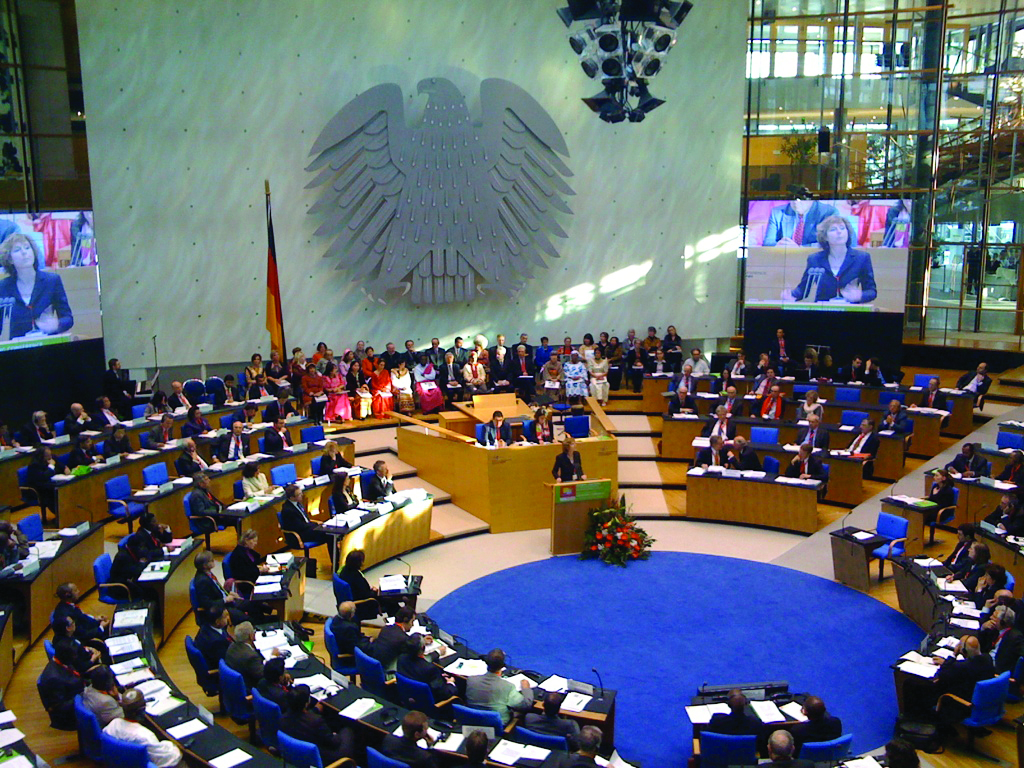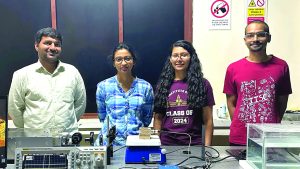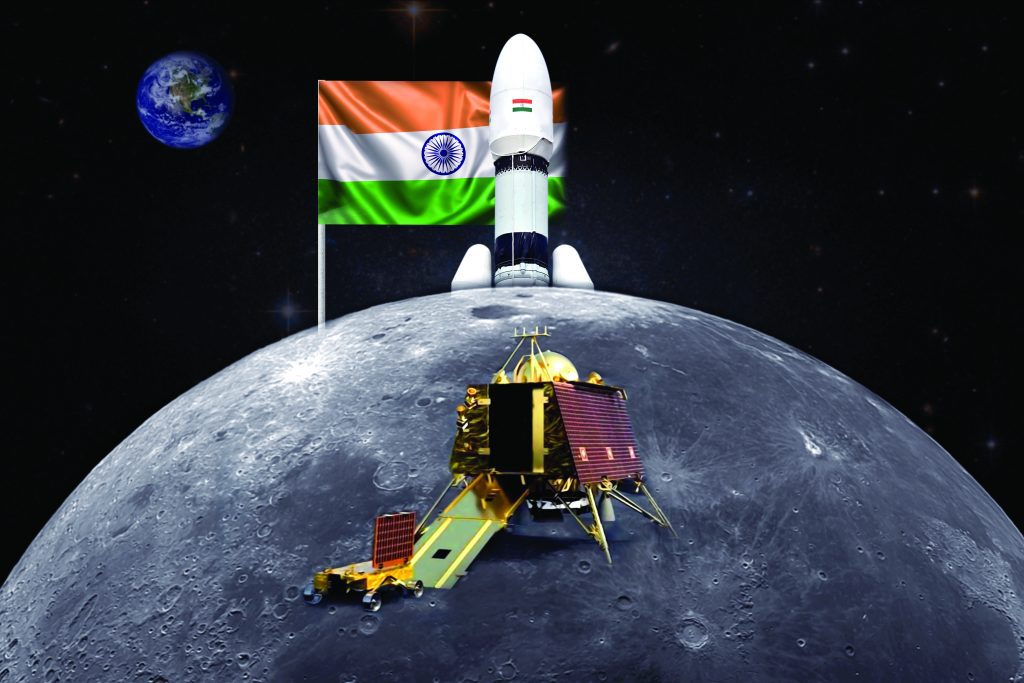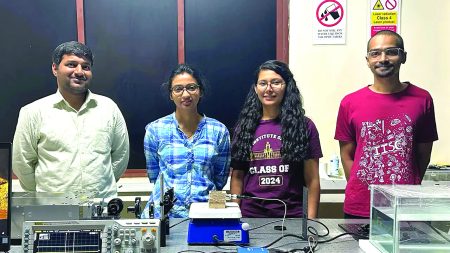On 23 August each year, India commemorates National Space Day, a landmark occasion inspired by the successful landing of Chandrayaan-3 near the Moon’s south pole. This historic event marked more than a technological triumph—it signalled India’s confident stride onto the world stage as a rising leader in science and technology. It was a bold message from an ancient civilization undergoing a dynamic transformation into a knowledge-era powerhouse.
India is no longer in the business of catching up. It is now creating new paths. At a time when technological supremacy defines global power, India stands ready not only to participate but to shape the future.
A HERITAGE OF DISCOVERY, A FUTURE OF DETERMINATION
India’s scientific journey stretches back millennia—from the astronomical insights of Aryabhata and the surgical innovations of Sushruta to the logic and empiricism of the Nyaya and Vaisheshika schools. In the modern era, this heritage was revived by pioneers like Homi Bhabha, Vikram Sarabhai, and Satish Dhawan, who built India’s nuclear and space foundations.
This legacy now finds expression in a youthful and ambitious India, which produces over 1.4 million engineers annually. World-class institutions like the IITs, IISc, and IISERs anchor a vibrant knowledge ecosystem. India ranks third globally in scientific publications and has surged from 81st to 40th in the Global Innovation Index since 2013. More than 100,000 patents are filed annually, and a thriving startup scene—over 3,000 deep-tech ventures—spans AI, space-tech, biotech, and clean energy.
India’s influence goes beyond labs and classrooms. Technological transformation is deeply embedded in public systems. Aadhaar, UPI, CoWIN, and DigiLocker demonstrate India’s strength in building scalable, inclusive digital platforms. In health, India is the world’s top supplier of vaccines and generic medicines. In space, its economy is nearing $10 billion, with ISRO and a growing private sector fuelling global collaboration. India also ranks third in installed renewable energy capacity.
In sector after sector, India is moving from imitation to innovation.
THE POWER METRIC OF THE FUTURE: TECHNOLOGY
In the 21st century, power is measured not in arms or arsenals, but in algorithms. A new cold war is taking shape—cantered on semiconductors, clean energy, quantum computing, and AI—not ideologies or territory. India is preparing for this era with a clear vision.
The government’s focus on semiconductors through Production-Linked Incentives and the development of fab plants signals a shift to high-end manufacturing. The National Quantum Mission aims to secure India’s place in the race for quantum supremacy. Digital regulations like the Digital India Act and Data Protection Law reflect India’s desire to shape, not just follow, the global norms on data and AI.
This goes beyond Atmanirbharta (self-reliance). India is becoming a crucial voice in conversations around AI ethics, climate technology, and space governance, championing open, inclusive, and human-centric approaches.


Image Courtesy: Pexels
Tech as Diplomacy: India’s Expanding Influence
Technology is now central to India’s diplomacy. Innovation in AI, clean energy, digital systems, and space science strengthens India’s global partnerships.
CHAMPIONING CLEAN ENERGY ON THE GLOBAL STAGE
India co-founded the International Solar Alliance (ISA) in 2015, now a coalition of over 100 countries promoting solar power. India’s involvement in the International Renewable Energy Agency (IRENA) and its bold climate commitments show its leadership in clean energy diplomacy. New focus areas such as biofuels and green hydrogen are widening this engagement.
A Responsible Voice in AI and
Digital Infrastructure
India is a founding member of the Global Partnership on Artificial Intelligence (GPAI), advocating for AI that is ethical, inclusive, and empowering. With over $1.2 billion invested in the IndiaAI Mission, India is scaling infrastructure, nurturing startups, and promoting AI literacy.
India’s digital platforms—like Aadhaar and UPI—have become models for the world. The CoWIN platform, used for COVID-19 vaccine distribution, has been adopted in countries across Asia, Africa, and Latin America. These tools now symbolise India’s global digital diplomacy.
SPACE: A FRONTIER OF COOPERATION
ISRO is an increasingly trusted partner globally. India has launched satellites for over 30 nations and is actively working with emerging space programs in Africa, Southeast Asia, and Latin America. The planned Bharatiya Antariksh Station, with its first module scheduled by 2028, showcases India’s long-term vision.
India’s satellite-based disaster and climate services add depth to its contribution to global resilience and cooperation.
Strategic Alliances for a Shared Tech Future
India is building alliances through multilateral forums like the Quad, BRICS, and G20. The India-US Initiative on Critical and Emerging Technologies (iCET) enhances collaboration on semiconductors, quantum computing, and AI governance.
The India Semiconductor Mission, backed by $10 billion in incentives, has attracted global giants such as Foxconn, Micron, and TSMC. These developments are integrating India into the global electronics supply chain.
India’s balanced approach to data governance and cyber law is emerging as a reference model for digital economies in the Global South.
HEALTH AND BIOTECH: HEALING BEYOND BORDERS
India reaffirmed its global standing as the “pharmacy of the world” during COVID-19 through its Vaccine Maitri initiative. Its robust biotech sector is now forming partnerships in genomics, biopharma, and bioengineering.
THE TECHNOLOGICAL RENAISSANCE OF A NATION
India’s recent decade has been transformative. The Chandrayaan-3 lunar mission and the Aditya-L1 solar observatory have secured India’s place in elite space exploration circles. Gaganyaan, India’s first human spaceflight program, is poised for launch.
The IT sector, contributing over $250 billion to GDP, with $200 billion in exports, continues to be a global engine of digital services. Cities like Bangalore, Hyderabad, and Pune serve as innovation hubs, with companies such as Infosys, TCS, and Wipro leading globally.


Image Courtesy: Twitter
The Unified Payments Interface (UPI) handles more than 10 billion transactions monthly, epitomizing scalable fintech. Digital India programmes are bridging urban-rural divides in governance, education, and health.
Frontiers like quantum computing and AI are being actively developed through the National Quantum Mission and IndiaAI. Green tech is gaining ground through the National Green Hydrogen Mission and India’s commitment to 500 GW of non-fossil capacity by 2030. Its pledge to reach net-zero emissions by 2070 confirms its global climate responsibility.
CHALLENGES AND THE ROAD AHEAD: RECKONING WITH THE GAPS
Yet, despite its rising profile, India’s tech renaissance remains vulnerable. The triumphs, though notable, sit atop a base that requires urgent reinforcement.
In April 2024, Nature magazine in an editorial, opined, “India is poised to become a science powerhouse. This is not yet a given, but it can happen.” The assessment was both hopeful and cautionary.
1. The Funding Deficit
India’s Gross Expenditure on R&D (GERD) is less than 0.7% of GDP, significantly below global peers like the US (2.8%) and South Korea (4.5%). What’s more revealing is the lopsided structure of funding: The private sector contributes less than 40% of R&D spending in India, whereas in most innovation-led economies, businesses lead the charge.
The Nature’s editorial calls for a systemic correction: Indian businesses must invest in science and research as a strategic imperative, not a corporate social responsibility add-on. Unless industries partner in long-gestation, high-risk research—from materials science to drug discovery—India risks stagnating in incremental innovation.
2. The Basic Science Blind Spot
India has done well in application-based and frugal innovation. But basic research, which catalyses paradigm shifts, remains marginalised.
Breakthroughs like the Internet, GPS, mRNA vaccines, and CRISPR were born out of curiosity-driven, foundational science—not quick-return investments. Without bolstering this base, India may miss out on defining the future of humanity’s most crucial technologies.
What is clearly needed, inter alia, is a mechanism of merit-based, long-term research grants, greater autonomy for research institutions, de-bureaucratisation of academic science, and incentives for high end and blue-sky research careers.
This blind spot once addressed shall pave the way for a focused and faster journey.
3. Governance & Culture Gaps
Innovation thrives in cultures of trust, collaboration, and intellectual freedom. Rigid hierarchies, excessive regulation, and fear of failure choke scientific curiosity. A thriving research culture needs flatter structures, peer-led evaluation, and space for dissent and diversity.
India must evolve from merely building institutions to creating ecosystems—where government, academia, industry, and civil society synergize seamlessly.
A CULTURAL REIMAGINING: SCIENCE AS ASPIRATION, NOT JUST OCCUPATION
India’s youth bulge—over five million STEM graduates annually—offers a historic advantage. But talent alone is not destiny. For India to truly harness this potential, science must be seen not merely as a profession but as a pursuit of wonder and national pride. Aspiration must be nurtured through visible role models, inspired storytelling, and joyful learning.
Scientists should be celebrated as icons, not confined to bureaucratic roles or specialist silos. Their stories and achievements must become part of our national imagination, amplified through cinema, literature, and media. In classrooms, science education must spark curiosity and delight, moving away from rote learning to inquiry-based engagement. Simultaneously, inclusion must be at the core—girls and students from marginalised communities must see themselves as rightful participants in this scientific journey.


Encouragingly, initiatives such as Vigyan Jyoti, Atal Tinkering Labs, and India’s increasing presence in international science fairs and Olympiads show this transformation is already underway.
Yet, as India pushes the frontiers of AI, gene editing, and space exploration, it must remain anchored in an ethical framework. India’s ancient worldview—rooted in ‘Vasudhaiva Kutumbakam’ (the world is one family), in sustainability, balance, and reverence for life—must inform its scientific vision. Only then can India offer the world not just innovation, but inspiration.
A VISION ROOTED IN WISDOM AND DRIVEN BY INNOVATION
India’s future in global science and technology depends on sustained investment in foundational research, equitable access to education, and ethical innovation. Supporting women in STEM, fostering homegrown deep-tech, and prioritising rural digital inclusion must become central goals.
If India can blend ancient wisdom with future-ready science, merge ambition with empathy, and pursue leadership with a global conscience, it won’t just rise—it will redefine the essence of leadership in the 21st century.
From lunar landings to digital diplomacy, from AI governance to green energy, India’s tech odyssey is more than a national story. It is an emerging blueprint for a fairer, smarter, and more connected world.
DESTINY AND DIRECTION: A SUPERPOWER IN THE MAKING
India’s moment has arrived—but it is fragile, contingent on the decisions of today. The pieces are in place: A vibrant demographic dividend, institutional frameworks, global interest, and geopolitical tailwinds.
But will we merely showcase successes, or systemically sustain them? Will we chase scale at the cost of depth, or build layered excellence? Will we replicate Western models, or carve a distinctively Indian path—one that balances modernity with morality?


As Nature rightly observed: “An opportunity to put rocket boosters under the country’s impressive scientific achievements is there for the taking.”
And as Vikram Sarabhai once urged: “We must be second to none in the application of advanced technologies to the real problems of man and society.”
India’s technological odyssey is not merely about catching up with the West. It is about showing the world a new way—scientific without being soulless, advanced yet accessible, fast but fair.
India’s journey in science and technology is at an inflection point. The pieces are falling into place—talent, ambition, infrastructure, and global relevance. But whether these become a mosaic of greatness or remain scattered achievements will depend on the choices we make today.
The journey has begun. Now comes the harder part—the vision, discipline, integrity, and unity needed to finish it.
Those of us, who have watched the much talked about recent podcast of Prime Minister Modi can only find their faith and conviction about India’s future reinforced emphatically. Here is a man, whose mind on India’s future role in the world and how he proposes to leverage technology, is so clear and so focused that no one can miss out the policy paradigms that are about to unfold.
And this perhaps is the best guarantee to India becoming a super power. India’s rise as a scientific superpower is not inevitable — it must be built. But the path is clearer than ever. Let us walk it with intent, with imagination, and with integrity.
* The writer, a Harvard educated civil servant, is a former Secretary to the Government of India. He also served on the Central Administrative Tribunal and as Secretary General of ASSOCHAM. He commands extensive expertise in the fields including Media and Information, Industrial and Labour Reforms, and Public Policy.










